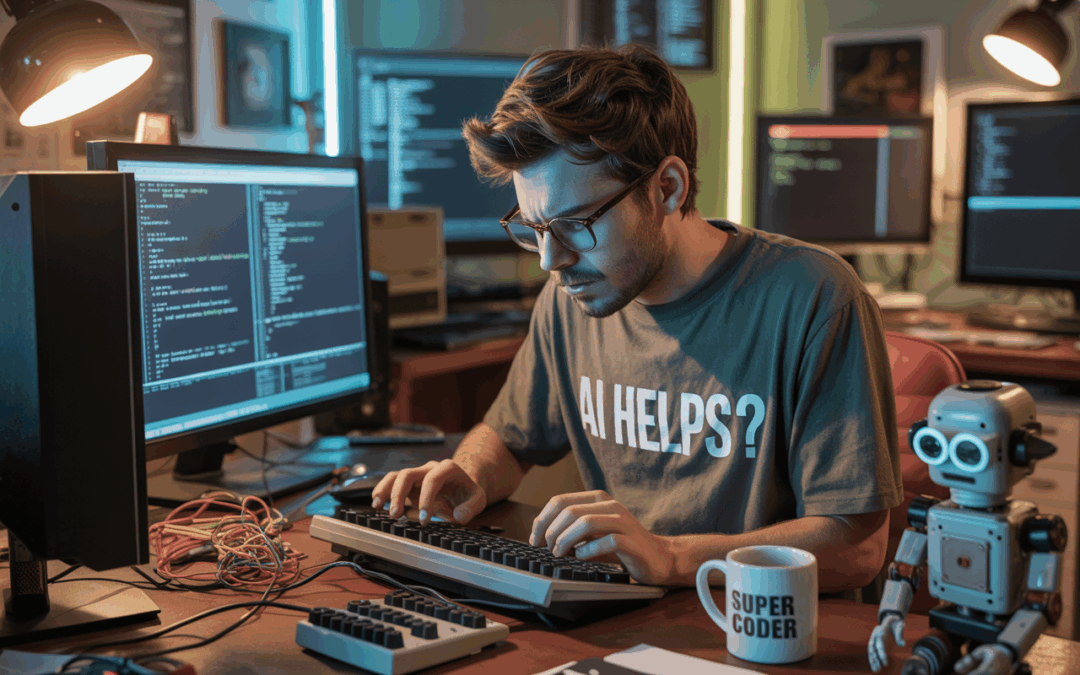This analysis sheds light on the complex and often paradoxical effects of AI tools on the productivity of software developers. While the recently published METR study surprising results in terms of a slowdown among experienced developers in specific contexts, a broader data base and general industry sentiment points to significant productivity gains when AI is used strategically.
The key findings make it clear that the effectiveness of AI depends heavily on the context, the specific tasks, the developer's ability to use AI effectively and the maturity of the AI tools themselves. There is a significant "perception-reality gap" where developers often feel more productive, even if objective measurements suggest otherwise. The future of software development will be increasingly "AI-native", which means a shift in developer roles towards higher-level problem solving, architectural design and human-AI collaboration, while democratizing software creation for non-technical users.
Over the next two to five years, proactive AI agents are expected to mature, capable of handling increasingly complex tasks autonomously. This evolution will require a strategic need to upskill the development workforce and focus on broader strategic applications of AI, such as reducing technical debt, improving security and modernizing legacy systems that provide quantifiable business value beyond mere lines of code. Organizations need to take a nuanced, data-driven approach to AI integration, investing in targeted training, comprehensive measurement frameworks and an adaptive strategy to realize the full potential of AI while mitigating associated challenges such as code quality concerns.
1 Introduction: The evolving landscape of AI in software development
The integration of Artificial Intelligence into software development is widely hailed as a transformative force that promises unprecedented efficiency, automation and innovation. Industry-wide surveys show a strong and growing intention to adopt AI in the software development lifecycle (SDLC). For example, 78 % of respondents worldwide say they are using AI in their software development processes or intend to do so in the next two years, a significant increase from 2023 (64 %). This widespread optimism is fueled by AI's potential to optimize workflows, automate repetitive tasks and accelerate product delivery, fundamentally reshaping the way software is created.
Despite this widespread optimism and rapid adaptation, one central question remains: Is AI currently speeding up or slowing down software developers? This report addresses this complex question by critically examining the findings of the recent METR study in the context of other prominent research and industry trends, before providing a forward-looking assessment for the next two and five years.
To fully grasp the current and future impact of AI, it is essential to understand the rapid evolution of AI agents. From rudimentary rule-based systems in the 1960s, AI has made advances in Natural Language Processing (NLP) and Machine Learning (ML) in the early 2000s, leading to sophisticated Large Language Models (LLMs) and Reinforcement Learning (RL) techniques in the 2010s. The early 2020s have seen the emergence of truly 'agentic AI', capable of perceiving environments, making decisions and executing actions to achieve complex goals, often without direct human intervention. This evolution from reactive tools to autonomous problem solvers provides the fundamental context for evaluating the role of AI in software development.
2. the METR study: a critical examination of the productivity of experienced developers
Study design, methodology and context (early 2025 AI tools)
The METR study is characterized by its rigorous methodology. It used a randomized controlled trial (RCT) in which 16 experienced open source developers participated. These developers had an average of five years' experience and 1,500 commits in their own large, established repositories, often comprising over a million lines of code and 22,000 GitHub stars. Unlike many decontextualized benchmarks, the study focused on real-world coding tasks - bug fixes, refactoring and feature enhancements - that were part of the developers' regular work. A total of 246 tasks with an average processing time of around two hours were analyzed. Early-2025 AI tools were used for the study, mainly Cursor Pro and Anthropic's Claude 3.5/3.7 Sonnet.
Main results: The discrepancy between perception and reality
The central and most unexpected finding of the METR study was that experienced developers using AI tools took 19 % longer to complete tasks than without AI support. This significant slowdown contradicted widespread expectations and the perception of the developers themselves. This deep discrepancy between the perceived and the actual Impact of AI on developer productivity indicates a strong cognitive bias.
Analysis of the factors contributing to the observed slowdown
- Insufficient AI responses: Current LLMs are often not "good enough to recognize exactly what a developer wants and respond perfectly in one go", which leads to considerable "back and forth".
- Review and cleanup: Developers spend about 9 % of their time reviewing and cleaning up imperfect AI-generated code, including debugging code not written by the human developer.
- Focus on experienced developers: The study focused on highly experienced developers working on projects that they understood deeply. In these areas, there is little room for significant acceleration through AI.
- Complex code bases: AI models have struggled in environments characterized by large, complex code bases, high quality standards and numerous implicit requirements.
- Cognitive distraction: The slowdown could also be due to factors such as the use of overly simple prompts, limited familiarity with the AI interfaces and some form of cognitive distraction from experimenting with the AI tool itself.
The METR study is strongly contextualized by the profile of its participants: experienced developers working on familiar, complex and high-quality codebases. In these environments, human developers have a deep, latent understanding of implicit rules, architectural nuances and historical contexts - a "pinnacle of human context". Current AI models struggle to fully capture this nuanced, implicit knowledge.
While the METR study objectively shows a speedloss the feedback from developers revealed a crucial qualitative aspect: the potential of AI to reduce cognitive load. For experienced developers, coding speed is often not the primary bottleneck; rather, it is the mental effort involved in dealing with complexity, context switching and repetitive tasks. If AI tools, even if they lead to a slight reduction in speed, significantly reduce mental effort, reduce frustration and increase job satisfaction, these benefits could outweigh a direct speed deficit.
3. current state of AI-powered developer productivity: a broader perspective
Evidence of productivity gains from leading AI tools
GitHub Copilot
- 55% faster task completion: Users complete tasks 55% faster.
- 90% improved job satisfaction: Developers report higher satisfaction.
- 73% remain in the flow state: Reduces distractions.
- 87% reduce mental effort: Especially for repetitive tasks.
- 88% Code whereabouts: Generated code is kept permanently in the project.
Claude & Agency Tools
- Best-in-class for real coding tasks: Claude 3.7 Sonnet.
- 10x increase in productivity: Some engineers at Anthropic (average 2x).
- 45+ minutes of work in one go: Claude Code can perform complex tasks autonomously.
- 70% Reduction of time-to-market: Companies that use Claude.
- 50% fewer bugs in production: Reported by Claude users.
- 1000% Increase in coding-related interactions: Claude recorded a massive increase.
General industry statistics
- 126% more projects per week: Developers with AI tools (Nielsen Norman Group).
- 25-50% efficiency gains: GitLab reports.
- 75% Increase in code insertion rates: Sourcegraph after Claude integration.
- 40% Productivity increase by 2035: PwC forecast for employees through AI.
- 2.6-4.4 trillion USD: Potential of generative AI for the global economy (McKinsey).
The clear contrast between the results of the METR study and other studies suggests that the effectiveness of AI is highly task-specific. AI excels at repetitive, clearly defined tasks (boilerplate, testing, documentation) and initial scaffolding, where it acts as a multiplier. With complex, nuanced or legacy code, however, the advantages diminish or even reverse.
Best practices for maximizing AI tool efficiency
Strategic planning & context management
Use "Plan mode" and CLAUDE.md-files to provide the AI with the correct context and destination.
Iterative & incremental approach
Divide complex tasks into smaller sections and use Test-Driven Development (TDD) with AI.
Human involvement for quality assurance
Don't aim for 100 % AI-generated code; human review and completion are critical.
Use of advanced tools & functions
Use of Model Context Protocols (MCPs), IDE extensions and advanced prompt engineering.
4. future outlook: The trajectory of AI in software development
The maturation of proactive AI agents and autonomous systems
The development of AI tools will accelerate significantly over the next few years, with a clear trend towards the maturation of proactive and increasingly autonomous systems.
Next 2 years (2025-2027)
Proactive problem solvers
AI assistants will predict requirements and make real-time suggestions for optimization.
Agentic AI matures
Will impact entry-level positions and perform tasks autonomously.
On-premise & customized models
Trend towards cost-efficient, fast and compliant AI models on site.
Natural language as the primary interface
Enables more interactive and engaging experiences.
Next 5 years (2027-2030)
AI-native software development
Gartner predicts that the majority of code will be generated by AI.
Semi-autonomous agents
Process thousands of lines of code, recommend architectural changes and refactor legacy systems.
Broader economic influence
Generative AI could contribute 2.6 to 4.4 trillion US dollars to the global economy every year.
The "early-2025" snapshot of the METR study is already being challenged by more recent developments and forecasts. Claude Opus 4's performance on SWE-bench and Terminal-bench, Anthropic's internal 10x productivity claims and Meta's advances in thinking all point to a rapid acceleration in AI capabilities.
Changing developer roles and the need for further training
- Expansion, not replacement: AI tools will augment, not replace, software engineers by improving human productivity, creativity and problem solving.
- Focus on higher-value tasks: Developers are increasingly focusing on creative, complex and strategic aspects of software design, architectural decisions and solving business problems.
- New roles & further training: Gartner predicts that by 2027, new roles in software engineering and operations will require 80 % of engineers to upskill.
- Human creativity & judgment: The "creative leap", judgment, negotiation skills, intuition and adaptation to "messy reality" remain uniquely human.
- Democratization of software development: AI will empower non-technical employees to create their own applications and automate tasks.
Strategic applications: Reduce technical debt, improve security and modernize legacy systems
- Application modernization: AI makes re-architecting and updating older systems financially viable.
- Improved security: AI-supported tools automatically identify, explain and eliminate vulnerabilities in the code.
- Transformation of DevOps processes: AI analyzes code changes, test results and production metrics for performance improvements.
- Abstraction of operational tasks: Integrated development platforms relieve developers of everyday work.
Anticipated challenges and opportunities in AI integration
Challenges
- Quality control: Risk of increased errors due to AI-generated code (e.g. +41% for co-pilot).
- Over-optimization of productivity: Without consideration of more comprehensive results.
- Complexity of integration: In existing, complex SDLCs.
- Learning curve: Mastery requires advanced prompt engineering.
Opportunities
- Developer satisfaction & retention: Reduces frustration and mental effort.
- Faster prototype development & innovation: Accelerates early project phases.
- Competitive advantage: Through improved efficiency and innovative solutions.
- New business models: By automating complex tasks.
5 Conclusion: Navigating the AI-supported development landscape
The impact of AI on software developer productivity is not a simple yes-or-no question. The METR study provides a decisive rebuttal for specific, highly experienced contexts and highlights current limitations in dealing with tacit knowledge and high quality standards. Nevertheless, numerous other studies show significant productivity gains, especially for repetitive tasks, for less experienced developers and when AI tools are used with mastery and strategic workflows. The discrepancy between perceived and actual productivity is an important factor to consider when assessing the value of AI tools.
The future of software development is undeniably AI-powered. Success will depend on a nuanced understanding of AI's strengths and weaknesses, a commitment to continuous learning and adaptation, and a strategic focus on human-AI collaboration. The role of the developer will shift from pure code creation to a stronger focus on architecture, strategic problem solving and the orchestration of AI agents. At the same time, AI will democratize software development by giving non-technical employees the opportunity to create solutions.
Recommendations for organizations:
- Pursue a context-aware strategy: Tailor the introduction of AI to profiles, task types and project complexities. A blanket introduction could lead to suboptimal results in certain scenarios.
- Invest in training and best practices: Priority should be given to training in advanced prompt engineering, AI agent management and human-AI collaboration techniques. The ability to interact effectively with AI and manage its outcomes is becoming a core competency.
- Holistic measurement: Comprehensive metrics should be implemented that go beyond pure speed to include code quality, cognitive load, developer satisfaction and broader business outcomes. This enables a more accurate assessment of the true value of AI.
- Encourage iteration and experimentation: Given the rapid development of AI, an agile approach to integrating new tools and functions is essential. Organizations should be willing to experiment, learn and continuously adapt their strategies.
- Planning for the "AI-native" future: It is advisable to start restructuring teams and workflows early for a future in which AI agents play an increasingly autonomous role in code generation and other development tasks. This also requires investment in the necessary infrastructure and platforms.
6. references
- [1] LinearB. (n.d.). Is GitHub Copilot Worth It? Available at: https://linearb.io/blog/is-github-copilot-worth-it
- [2] Understanding AI. (n.d.). Claude-powered coding tools are poised to supercharge developer productivity. Available at: https://www.understandingai.org/p/claude-powered-coding-tools-are-poised
- [3] Digital Applied. (n.d.). Claude Code AI Development Revolution. Available at: https://digitalapplied.com/blog/claude-code-ai-development-revolution
- [4] ArXiv Research. (n.d.). Measuring the Impact of Early-2023 AI on Experienced Open-Source Developer Productivity. Available at: https://ar5iv.labs.arxiv.org/html/2302.06590
- [5] Anthropic. (n.d.). Introducing Claude 3.7 Sonnet. Available at: https://www.anthropic.com/news/claude-3-7-sonnet
- [6] The Business Dive. (n.d.). AI productivity statistics: What the data says. Available at: https://thebusinessdive.com/ai-productivity-statistics
- [7] Okoone. (n.d.). Why Claude is the next big thing in software development. Available at: https://www.okoone.com/spark/technology-innovation/why-claude-is-the-next-big-thing-in-software-development
- [8] Contrary Research. (n.d.). Windsurfing. Available at: https://research.contrary.com/company/windsurf
Matthias (AI Ninja)
Matthias puts his heart, soul and mind into it. He will make you, your team and your company fit for the future with AI!
About Matthias Trainer profile
To his LinkedIn profile



